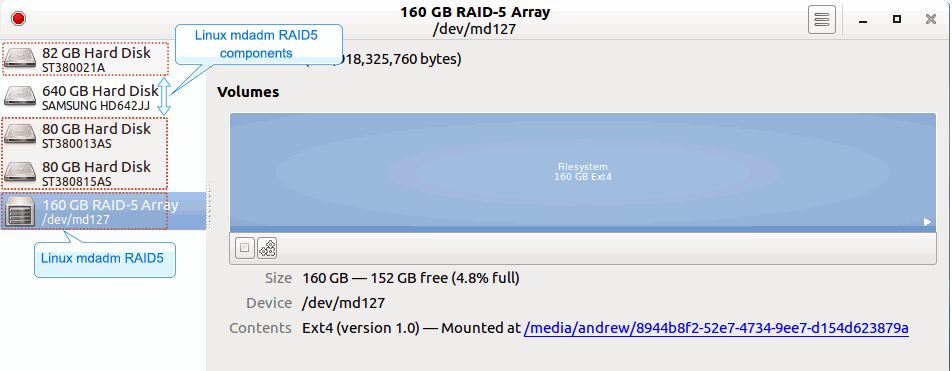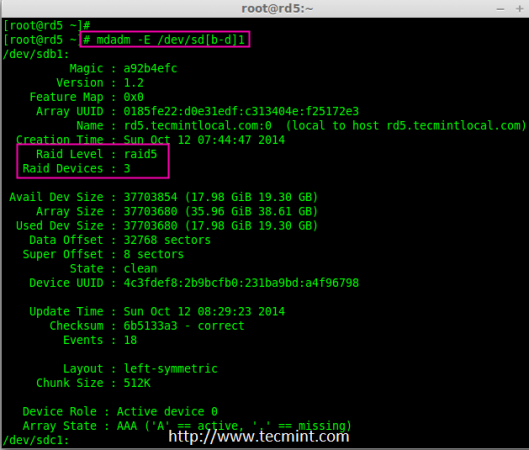
Then save the file and restart mdadm by executing the command: /etc/init.d/mdadm restart To set this up, simply edit /etc/nf ( or /etc/mdadm/nf if it is Debian) file and add the following line: MAILADDR replacing with your email address.
Raid monitor linux software#
At Fraction Servers we do not monitor customers RAID arrays and recommend any customer using software RAID setups monitoring of their RAD arrays. It is very simple and very useful at the same time to setup email alerts, so if there is something wrong with RAID setup, you will receive an email. Setting up Email Alerts for RAID Monitoring If you need more details about the specific RAID device, just run the following command, replacing /dev/md126 with the name of the device, you wanted to check: ~]# mdadm -detail /dev/md126Īrray Size : 975872 (953.00 MiB 999.29 MB) To check the health status of your RAID array, you can simply run the following command: ~]# cat /proc/mdstat

Note: If you are using Debian operating system the nf file will be located at: /etc/mdadm/nf Checking RAID configuration and statusĪll essential information about RAID devices are stored in ‘/etc/nf’ file, which looks similar to the following: ~]# cat /etc/nfĪRRAY /dev/md/boot level=raid1 num-devices=2 UUID=f8ce33fe:afd0b1b5:7aedbcf9:13e967d3ĪRRAY /dev/md/root level=raid1 num-devices=2 UUID=a7866d4d:ec7a94a9:dc0e1c5a:76848e6bĪRRAY /dev/md/swap level=raid1 num-devices=2 UUID=faca3cc3:7da4398b:5b42d265:3d14b0e2 The levels of RAID are explained in detail here: However the most popular ones for redundancy are RAID1 (Mirroring) and RAID 10 (Striping and Mirroring). Linux Supports the following software RAID levels: RAID 0 (No Redundancy), RAID 1, RAID 4, RAID 5, RAID 6, RAID 10. Most RAID levels will allow some degree of drive failure, which is useful to protect important data. With Linux, it is possible to use RAID without a need to have a hardware RAID controller, with both software and hardware RAID supported. It basically is a virtual device created from physical drives or partitions. You won't have any way of visually determining drive array status or doing this via your host.RAID is an acronym of ‘Redundant Array of Independent Disks’. The enclosure being used here does not have LED indicators for drive health. Provide more information about the device, and there's a slim chance status can be communicated to the host (if using the right card), but I wouldn't expect it otherwise. What type of eSATA host card are you using?Īt this point, I would rely on the enclosure and visual LED status checks to determine array health.
Raid monitor linux driver#
Adding a layer of abstraction through eSATA almost eliminates any chance of your drives being exposed to the OS, unless the card you're using in the host has OS-lever driver support. As a result, port multipliers are somewhat rare and don't have much mindshare. Expanders are the norm for server backplanes and external storage JBOD enclosures. Using a SAS expander is the preferred and more supportable approach. It's not surprising that you've had a difficult time finding information about the SATA port multiplier and monitoring under Linux. Heck, using SATA is a bit risky these days, with ever-increasing drive capacities. The use of SATA multipliers is a no-no in server-class systems. You may be one of the only people who have run into this issue :) I'm looking for a way to do this in Linux and then potentially add to Nagios, etc. There are utilities to check/set the RAID settings in OSX/Windows, so it is apparently possible. I looked at some libatasmart tools, but couldn't find anything regarding SATA port multipliers in general. RAID status is my big concern, but actual drive models would be helpful too.

sd 4:0:0:0: Attached SCSI diskĪny guidance on peering at the system underneath would be appreciated. sd 4:0:0:0: Write cache: disabled, read cache: enabled, doesn't support DPO or FUA Linux sees and handles the sata device just fine, but I'm wondering if there's any way to query/monitor the RAID5 status that's hiding behind this HW RAID.

I am using an external eSATA device which takes 5 SATA drives and presents them as one large HW RAID5 to linux (ubuntu).


 0 kommentar(er)
0 kommentar(er)
